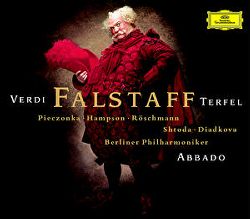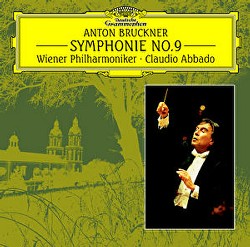
Ogni registrazione verdiana di Claudio Abbado è un avvenimento. Questo Falstaff , la cui incisione risale alla scorsa primavera 2001, non è une ripresa delle rappresentazioni di Salisburgo, ma una registrazione originale fatta alla Philharmonie, con Bryn Terfel nel ruole del vecchio Sir John e Thomas Hampson in quello di Ford.
Falstaff
Sopran: Adrianne Pieczonka · Dorothea Röschmann
Mezzosopran: Stella Doufexis
Alt: Larissa Diadkova
Tenor: Anthony Mee · Daniil Shtoda · Enrico Facini
Bariton: Bryn Terfel · Thomas Hampson
Baß: Anatoli Kotscherga
Orchester: Berliner Philharmoniker
Dirigent: Claudio Abbado
2001 Deutsche Grammophon
2 CD 028947119425
lieferbar ab 10.07.2001
Article by Claudio Abbado
"This is my kingdom. I mean to extend it." - "We are all figures of fun!"
by Claudio Abbado
The lessons that Verdi passed on in his work were enormously important in paving the way for many musical innovations of the 20th century, and, in the case of Falstaff, aspects of its dramaturgy and music prompt us to speak of a "revolution with a smile". With laughter anything can happen, things can be looked at differently, sometimes turned completely upside-down. And while Verdi does not stray from the traditional comic pacing he inherited from Shakespeare, his expressive means are utterly new and original. Concerning his use of chromaticism, a letter already shows Verdi in 1867 upbraiding critics for having missed the Wagnerian character of many passages in his operas, such as the trio in Ernani or the Sleepwalking Scene in Macbeth.
A fundamental element in Falstaff is heard in the very opening bars: the way the vocal delivery, ranging from declamation to song, and the orchestral writing, are shaped to match the development of the action. And, picking up on all the comic ideas in the text, Verdi often writes in a way that makes the orchestra itself seem to be laughing. For example, Falstaff's discourse on the need to feed his enormous paunch is brilliantly depicted in different timbres and harmonies, and the texture is slimmed down to only piccolo and cellos to emphasize the danger that his figure might "grow thin".
Verdi's extraordinary ability to create a mood by musical means informs the entire score. Take, for example, the sharply contrasted scenes of the first act: after the grotesque darkness of the scene at the inn comes the freshness and animation of the feminine outdoor scene, bursting with the joy and vitality of the women's greetings to each other. When Alice and Meg read the two identical letters and ironically act out Falstaff's words, ending with a heavy caricature of the phrase "E il viso tuo su me risplenderà / Come una stella sull'immensità" (And your face will shine upon me like a star upon the vasty deep), the immensity of Falstaff's love is wittily associated with the immensity of his physique. The sparkling women's quartet that follows is nothing less than a hymn to feminine intrigue, which reaches its climax when the women decide not only to play a trick on Falstaff, but also to help Nannetta escape the overbearing Ford and Dr. Caius. And after Pistol has finally given Ford an outline of Falstaff's intentions ("To put it briefly: that enormous Falstaff wishes to enter your house, entice your wife, break into your coffer, and dishonour your bed."), Ford's angry outburst is followed by the two companions' explanation, ending with the fatal words whispered by Bardolph over the darkest timbres in the orchestra, reduced to lower strings and wind: "le corna" (the horns).
The end of the first act again demonstrates how Falstaff plays on the mutual attraction and opposition of men and women, when the sexes are now divided in their secret schemes. The women, together with high woodwind, and the men, with the rest of the orchestra, sing in different rhythms, while Fenton's voice rises up above all. Amid carefree exchanges and arrangements for the next day, we hear once again Alice's mockingly passionate phrase directed at Falstaff, "E il viso mio su lui risplenderà", which concludes with a great burst of laughter. Thus ends the first act, with the women picturing Falstaff puffing up and bursting, already anticipating their final victory.
Of course the score abounds in examples of Verdi's original use of instrumental timbre and register. At the beginning of the second act Mistress Quickly sings her "Reverenza" to a courtly dance rhythm, and this phrase, together with the tags "Buon giorno, buona donna" and "Povera donna!", punctuates her conversation with Falstaff. At the end, Verdi leaves it to low strings alone - violas and cellos - to offer an ironic echo of the gesture. The little quaver (eighth-note) triplet figure which defines the time when Falstaff can meet Alice while her husband is out, "from two until three", is likewise a cheerful motto, while references to Meg, the other presumed victim of his charm, are accompanied by sensual harmonies. There are nostalgic echoes to be heard as well, as in the aria "Va', vecchio John", where Verdi scores the heavy rhythm for strings, bassoons, trumpets, trombones and timpani to emphasize the protagonist's pathetic narcissism.
Still in the second act, as Alice strums a Spanish-sounding phrase on the lute (actually an offstage guitar), Falstaff enters and declares his love, even wishing her a widow in order to make her his wife. Matching the words "T'immagino fregiata del mio stemma, / Mostrar fra gemma e gemma / La pompa del tuo sen" (I can picture you adorned with my crest, displaying the splendour of your bosom amid a wealth of gems), the bassoons ridicule Falstaff's amorous ecstasy with an irreverent figuration that contrasts with the lyrical tones in which he compares Alice to a diamond. Even in Ford's frantic efforts to expose Alice's affair with Falstaff, dramaturgy and music are completely fused together. A recurring motif of four semiquavers (16th notes) represents the enraged husband's senseless rushing about, until we reach the ensemble in which Mistress Quickly's lines are accompanied by flute and piccolo, Meg's by the oboe, and the aggressive interventions of Dr. Caius and Ford by four horns, marked piano. And it is to this very same recurring semiquaver figure that Alice re-enters to direct the final scene, with poor Falstaff thrown into the Thames amid general laughter and the din of the whole orchestra.
Verdi also frequently introduces novel harmonies and sonorities. For example, in the third act, when Mistress Quickly and Alice tell the story of Herne's Oak, Verdi scores the accompaniment for four horns against the background of a single high piccolo. The first horn is in dialogue with the two women, while the other three play low notes to evoke the stroke of midnight, with a sequence of harmonies on the words "sorgon gli spirti vagabondi a frotte" (wandering spirits arise in flocks) which create abrupt, unusual modulations. Alice tells the macabre story to the rhythm of a march which finds the whole orchestra playing in the bottom register: trombones, bass trombone, horns, bassoons and, unusually, oboes and clarinets as well. Through this sensitive use of orchestral colour Verdi conjures up the spirit of a witches' sabbath, which frightens both Nannetta ("Oh! Che spavento!" - Oh, how terrifying) and Meg ("Già sento il brivido della paura!" - I feel the shiver of fear already).
In the forest, after the noisy theme announcing Falstaff's appearance, every stroke of the bell on the note F brings a change of harmony, from one unexpected chord to another. And the scene of Falstaff's hounding gets underway with a dissonant second. After Falstaff has been forced on to his knees, rapid orchestral volleys in a relentless 2/4 rhythm represent the strokes of a whipping. The dramatic power of this passage arises from a counterpoint of contrasting musical elements: the parodied litany of the women invoking divine retribution ("Domine, fallo casto!" - Lord, make him chaste!), the four men who continue with their insults ("Pancia ritronfia" / "Vuota-barili" / "Sfianca-sedili", etc. - Bloated belly, barrel-swiller, chair-breaker) to the same relentless rhythm, Falstaff, in a lamenting cantabile line trying to moderate the punishment ("Ma salvagli l'addomine" - But spare my belly) and the chorus of fairies and sprites recalling the preceding 6/8 rhythm ("Pizzica, pizzica, pizzica!"). Just as Shakespeare before them, Verdi and Boito here create an ingenious and original fusion of fairy-tale and comedy, that reveals life's most serious, profound truths in the context of magic and laughter.
Thus, throughout Falstaff, by reviving the legacy of folk comedy assimilated and developed by Shakespeare, Verdi creates a style filled with original harmonies and timbres that always serves dramatic logic, so that the drama and the music, as shown above, tend to shape one another. Although the musical ideas seem to spring from the stage and express the text, they take on a life of their own, and penetrate an orchestral and vocal texture whose innovative procedures would have a profound effect on subsequent developments in the history of music and opera.
|


